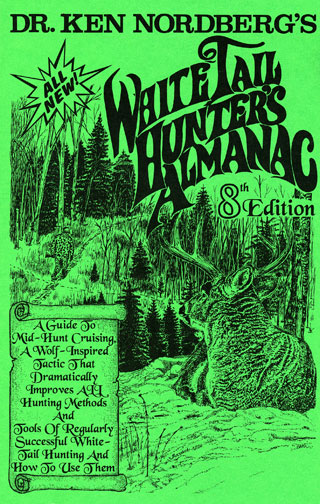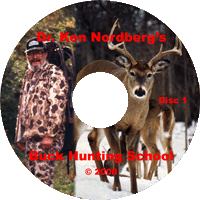Big Bucks I Should Have Taken But Didn't
By Dr. Ken Nordberg
[The following is the another of many older articles that will appear on my website. This is article was first published in Midwest Outdoors in December of 2012. Please share what you learn from these aricles with your whitetail hunting friends.]

A Beautiful Big Buck!
Throughout my 66 seasons of whitetail hunting I've certainly experienced my share of goof-ups, most notably when big bucks were involved. Following most error-stricken moments I usually realized what I had done wrong and vowed to never make the same mistake again, but today I cannot deny the fact that occasional goof-ups are an unavoidable part of buck hunting.
My introduction to such errors occurred the second morning of my very first deer season. Very wet behind the ears, I was one of six drivers heading toward six standers when four deer—a doe, two fawns and an 8- or 10-point buck—suddenly appeared in a small opening 50 yards ahead of me. Right then an unseen stander at least 100 yards beyond and to the left of those deer began talking out loud to a driver who had ended his line of the drive ahead of me. Those four jittery deer then bolted, bounding straight back toward me, the doe in the lead. When I raised my new 30-30 carbine and began firing, my first bullets plowed into the snow behind the deer while all four were at the tops of their great leaps, but they kept coming. As they drew nearer, however, the doe went down, then a fawn. The second fawn plummeted to the ground at my feet, knocking me flat on my back but I scrambled to my feet in time to take aim at the buck (the first big one I had ever seen in the wilds) as it passed only ten feet away. When I pulled the trigger, however, the only sound I heard was a metallic click. In my haste to fire at those deer, I had wasted shots and ran out of bullets one too soon. Though I received a lot of vigorous handshakes for my extraordinary good luck that morning, I could not get over the disappointment of failing to take that big buck—the kind of deer I had repeatedly dreamt of during the weeks preceding my first hunt.
During the first few hunting seasons that followed, I never came close to matching the extraordinary shooting ability of some of the veteran hunters in our group who routinely dropped driven deer bounding past through dense forest cover. I was therefore designated a "permanent driver" and never again saw another big buck during our endless drives. In fact, though we almost always "filled out" within a few days, no big bucks were taken by any of our bunch throughout the years I hunted with them. Ever disappointed, I finally talked my father into leaving the old gang so we could begin using some different hunting methods.
My first attempt at stand hunting (stump sitting) came the following year and almost at once I became convinced this was a great way to hunt bucks. At first light I spotted a big eight-pointer about 100 yards away trotting straight toward me. Too anxious, again, I immediately raised my 30-30 (with open sights) and fired off-hand. I missed, of course, and the buck disappeared before I could lever in a fresh round and raise my rifle.
"Boy that was stupid," I then realized. "I should have waited until it was much closer. I've got to learn to be more patient."
The chance to do this came a few hours later. I was sitting on a log about a half-mile away with my back against the wide trunk of a towering pine when I noticed some glints of sunlight on a distant hillside. I soon discovered those glints were coming from antlers of a mature buck moving slowly in my direction, following the deer trail that coursed past my feet. Determined to heed my own earlier advice, I decided to wait and see how close the buck would come.
At 50 yards I could see it was a fully mature eight-pointer. At 25 yards I realized because it was relatively open between me and the oncoming buck, I should have raised my rifle sooner while the buck was farther away and its eyes were hidden behind intervening tree trunks. Soon the buck was only 15 feet away, and then only ten. At that point it must have finally gotten a whiff of me because it suddenly rose up on its hind legs, likely intending to whirl and flee back in the direction from which it came. Faster than I later deemed possible, I raised my 30-30 and fired, hitting the upright buck in the center of its brisket and dropping it in its tracks. Astonished, I had finally taken my first big buck.
By 1972, my own family of young hunters and I had become quite proficient at constructing and using permanent tree stands to hunt bucks only, back when whitetails did not expect to find human hunters in trees.
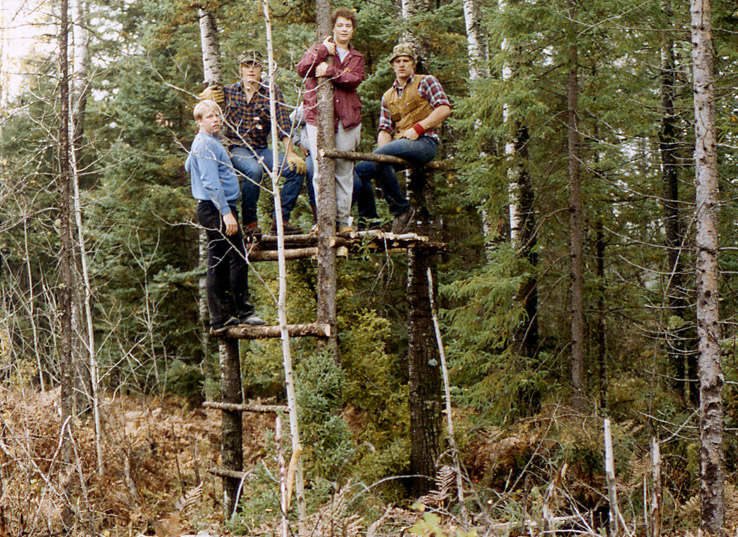
One of Dr. Ken Nordberg's early-style permanent tree stands. (Time frame: about 1978)
Left-to-right: Kevin Stone, Ken Nordberg, Peggy Stone, David Nordberg
The stand I planned to use one opening morning had a couple of new innovations: body-masking evergreen bows nailed to the railings around the platform and a tunnel-like approach trail passing through especially dense evergreen cover.
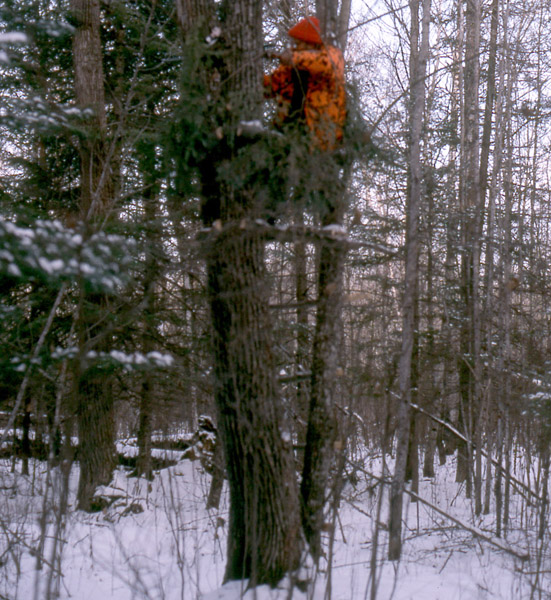
Doc in Tree Stand
One reason Dr. Ken Nordberg is famous is for teaching deer hunters
how to hunt whitetails using tree stands like this.
(Note the extra evergreen bows attatched around the sides.)
There at first light I spotted a buck with the largest 10-point rack I had ever seen in the wilds up to this time, facing me about 40 yards away. I slowly raised my new rifle (a bolt-action chambered for 7 mm magnum), centered the crosshairs of my scope (a two- to seven-power variable set at three-power) on the middle of the buck's chest and squeezed the trigger. At the shot the buck turned and trotted away, tail down. I didn't fire again because I was certain my shot was fatal. An hour of intensive searching, however, failed to turn up one drop of blood or any hair. While returning to my stand later, I noticed a freshly cut branch on the ground beneath a sugar maple. Back in my stand I could see that branch had been in a direct line with the buck. This was my first of several shots that revealed my 7 mm magnum is no so-called "brush gun," not like my old 30-30. Upon hitting an intervening branch my fast-moving magnum bullets either exploded or ricochet. I thus learned to make certain I have a clear shooting window through cover before firing at a buck.
My most colossal error occurred a year later. I was sitting on a log on a narrow ridge where it connects to a ten-acre wooded highland out in the middle of a huge alder swamp, a likely place, I figured, to find a buck late in the hunting season. After nearly an hour of watching a deer trail that coursed past inside the edge of that highland, I decided to move. Before picking up my rifle, I stood up to stretch. Almost immediately, 10-12 whitetails leaped from beds in an area only 20 to 40 yards away and began bounding into the alder swamp. Stricken with disbelief, I grabbed my rifle and swung it from left to right, hoping to find antlers in my scope among that myriad of bobbing whitetails. Too briefly to fire, I glimpsed one buck with an enormous rack (my teenage daughter, Peggy, dropped this buck the following day, a 10-pointer that always makes hunters shake their heads in awe upon seeing it on the wall).
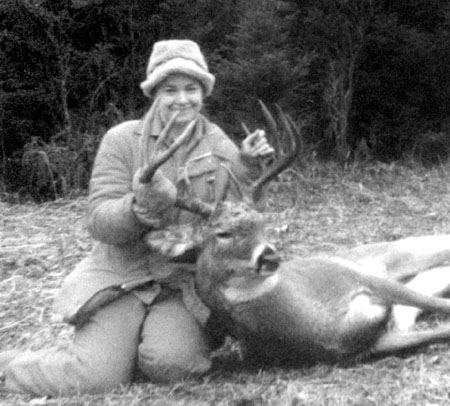
Peggy with her big 10-pointer.
This episode taught me two things: whitetails can be amazingly near without you realizing it and you shouldn't always expect to see deer where you expect to see deer. They're just as likely to be on your right or left or maybe even behind you. I learned this again the following hunting season.
While sitting in one of our permanent stands watching an area known in our camp as "Hazel Haven," an area full of red osiers which are a favorite winter food of our northern Minnesota whitetails, I spotted some antlers sticking up above the hazels about 75 yards away. To get a better look at them (using my binoculars), I stepped up onto my railings, straddling a tree trunk at one corner of my stand. The deer turned out to be a six-pointer. Though I did not intend to take it, I was so entranced by the sight of it feeding that I didn't step down from my high vantage point for nearly 20 minutes. When I did, pandemonium ensued beginning with a loud snort behind me, almost directly beneath my feet. I can still visualize the sight of that buck. It seemed to be as wide as a whiteface steer and its tall, ivory-tipped antlers extended far beyond the sides of its body. I didn't actually see this buck until it was in the air, making the one great leap it needed to disappear into a dense stand of balsam firs.
At noon years later (1999), suspecting a midday feeding cycle was in progress, I hurried toward a blind I had made overlooking a three-year-old clear-cut. About 200 yards short of my intended destination I unexpectedly jumped a very acceptable eight-pointer, briefly glimpsing its antlers as it bounded through evergreens ahead of me on my stand site approach trail. Hoping to spot this buck before it crossed the clear-cut, I followed as rapidly as I could without making telltale sounds, crawling the last 10 yards to my blind to remain out of sight. When I peeked over the top (my camo headnet pulled down), four feeding deer were in sight, but none had antlers. Thinking the buck might be hiding in an island of mature timber 70 yards due west of where I sat, I began scanning it with my scope. The loud snap of a branch much nearer then got my attention. Using my scope, I finally located hair-covered parts of a deer standing without motion in dense brush only 25 yards away, and though I couldn't see much of it, it definitely had antlers. Assuming it was the eight-pointer, and upon finally finding a small opening to the base of its neck, I fired. It was an eight-pointer all right, but not the one I jumped earlier. This one was a 2-1/2-year-old with an inside spread of only about 12 inches.
Sometimes you can wait too long to fire. I'll never forget the snowy morning I was watching the feeding area we call "Horseshoe Valley." About 8 a.m., a dandy 10-pointer emerged from a heavy swirl of snow on the opposite side of the opening 100 yards away. I could have shot it there (I dropped a 13-pointer at the same spot a few seasons later), but because it had been heading toward me, I decided to wait until it was nearer. About then, snow began falling more heavily, completely hiding the buck and I never saw it again. Later, I told myself, "When you've got an easy shot like that, you should never pass it up in favor of an easier one that might not happen."

Doc with a big whitetail he didn't miss.
It was the last day of the hunting season and I had yet to take a buck. At this point the six-pointer everyone in camp had passed up became a worthy quarry. As I cautiously began climbing the slope where it had often been seen, it suddenly snorted and leaped over the crest of the hill above me, then bounding north out of sight along the edges of four adjoining beaver ponds. Figuring it was likely heading for the only crossing to the opposite side of the ponds, nearly a mile north, I reversed direction and headed quickly around the upper pond, hoping to ambush the buck sneaking back on the trail south of the crossing.
It wasn't a bad idea because the buck's tracks in snow revealed it had unnecessarily done this when one of my sons passed it a few days earlier. As I started down the slope east of the beaver dam near the north end of the first pond, moving fast and watching where I put my feet, a deer suddenly snorted on my left. Before I could react, a 10-pointer with huge antlers leaped high across the trail ahead and bounded north out of sight. Its swift, non-stop progress was made evident for several minutes by snapping branches and heavy hoof beats. In my haste to take a six-pointer, I had missed a chance to take a trophy-class 10-pointer. The old axiom, “haste makes waste,” also applies to whitetail hunting.
My last unforgettable goof-up occurred three seasons ago. If you have read my articles over the past few years, you will probably remember my anguished annals describing encounters with a certain red-antlered buck. I had briefly fallen asleep on my stool behind a makeshift blind overlooking a freshly renewed ground scrape when the first of these encounters occurred. I suddenly awoke with a jerk and for no discernable reason turned my head to the right, finding myself staring with astonishment into the eyes of an enormous red-antlered ten-pointer, thirty feet away. While my mind began scrambling to decide what to do, the buck became airborne. It's first soaring leap took it to its ground scrape 25 feet east and then with a right angle twist its second great leap sent it plunging south through eight-foot-high boughs of the first of a solid screen of black spruces.
Much more than other deer, big bucks are cunning and lucky. The lucky part occurs because the mere sight of one can be unnerving enough for most human hunters, debilitating enough for some (those stricken with buck fever) to tip the scale in favor of the buck. Though big bucks are the most challenging of whitetails to hunt, if you are good at it, hunting them is the most exciting and rewarding whitetail hunting there is.
Good Luck Hunting,
Doc
Dr. Nordberg has written nine, long popular whitetail hunting instruction books based on more than three decades of scientific, hunting-related studies of wild deer over much of North America. Each covering different subjects, his books introduce several new and much improved hunting tactics, one wolf inspired, developed to make you regularly successful at hunting mature bucks (and other deer) with gun or bow. For order forms and more information about his books, sign guides and newly released DVDs from his famous buck and bear hunting schools go to www.drnordbergondeerhunting.com.
Good Luck Hunting,
Doc
(Dr Ken Nordberg is semi-retired. For example, he no longer gives his famous Buck Hunting School in the spring. However, the last two years he gave his school was captured on video by his son John, and made into a 10-disc DVD series. This masterful presentation on hunting trophy-class whitetails bucks is available to you now. For more information, please follow this link. Also on eBay.)







